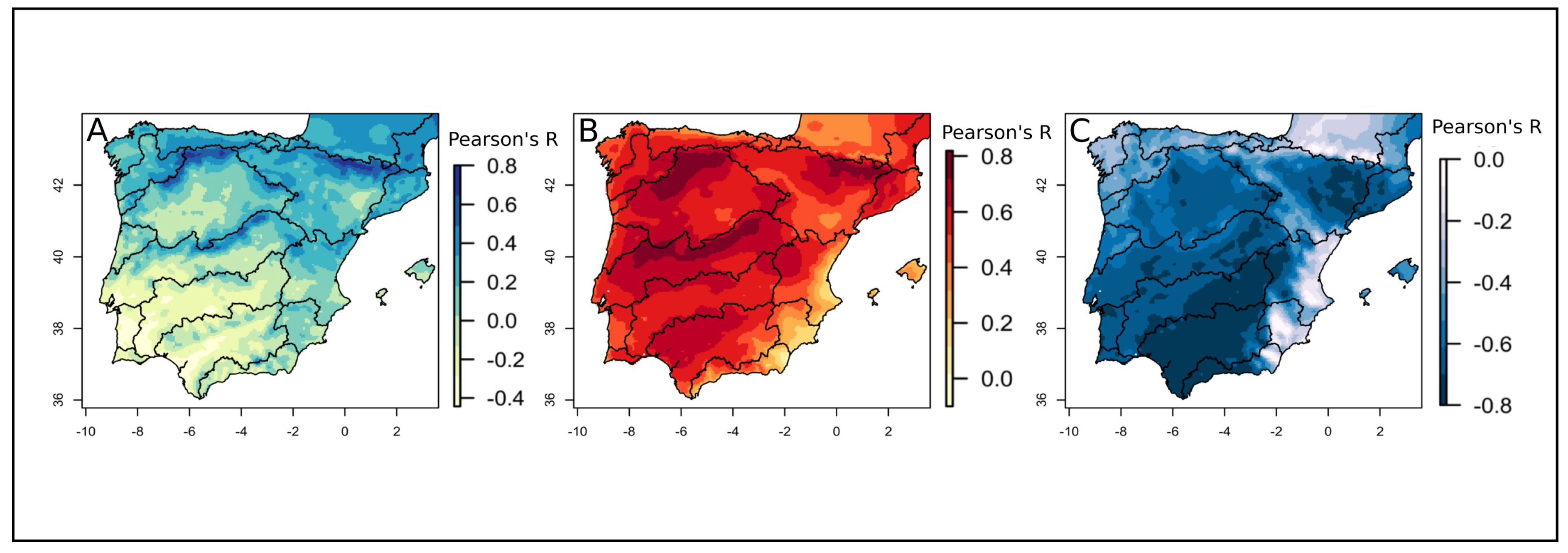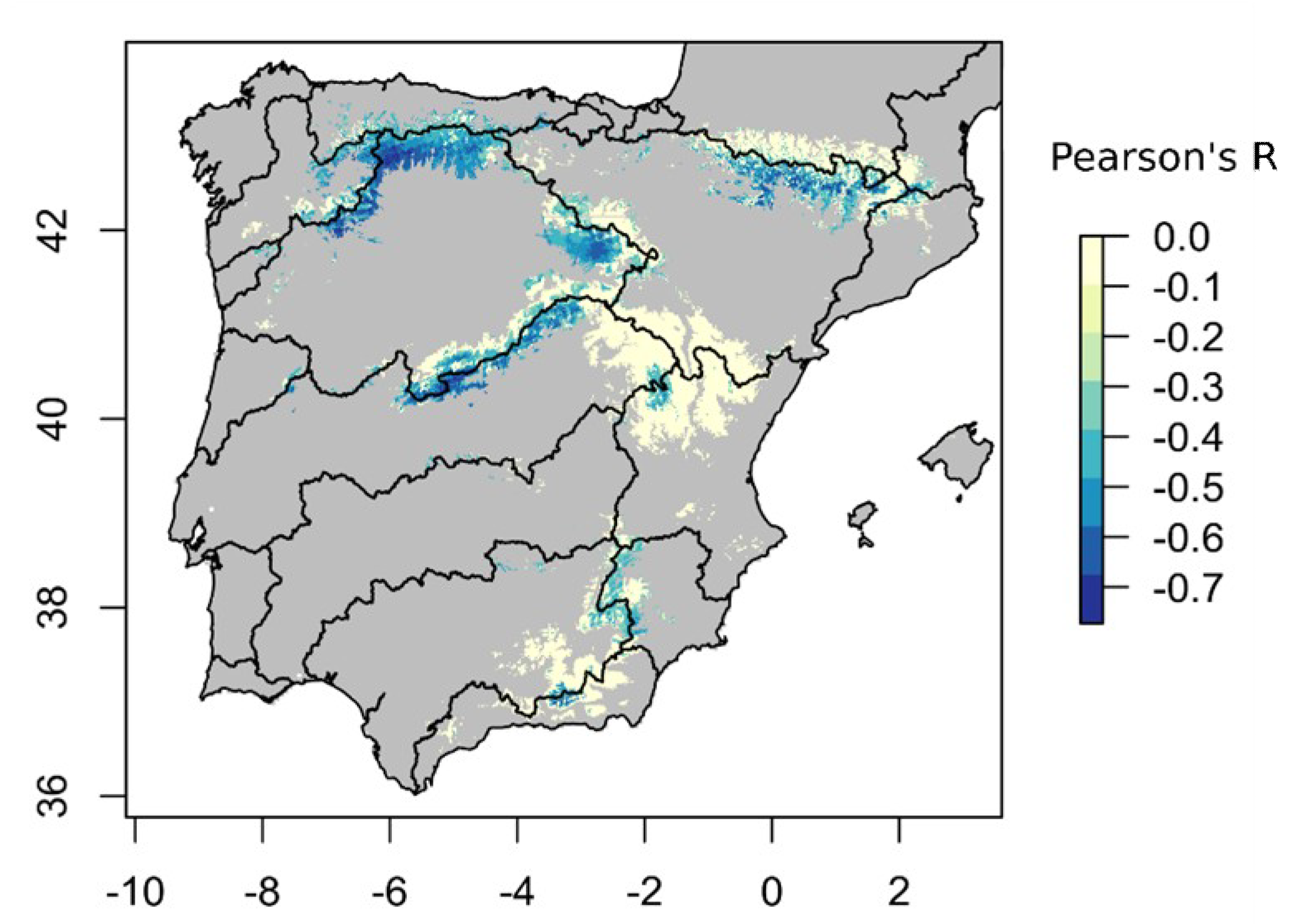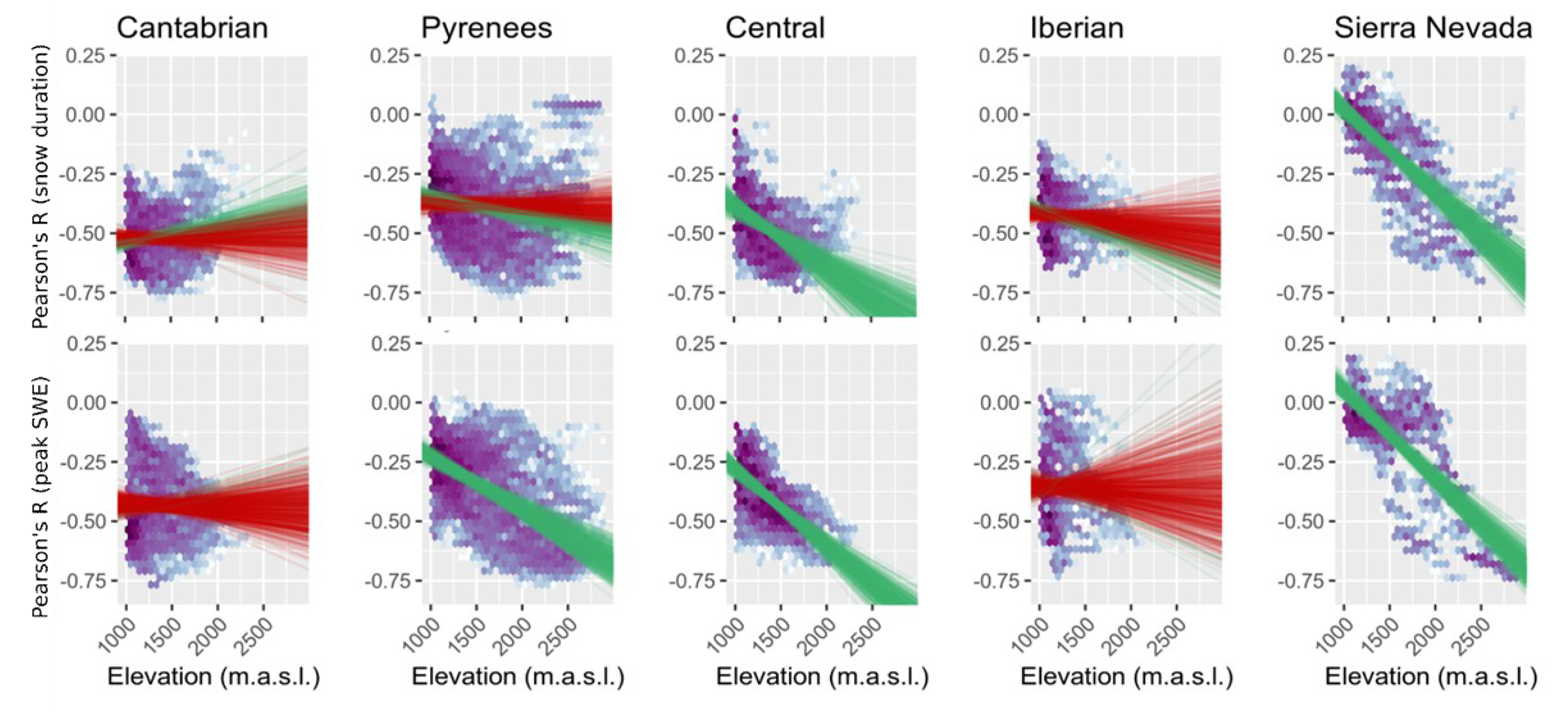Impact of North Atlantic Oscillation on the Snowpack in Iberian Peninsula Mountains
Abstract
:1. Introduction
2. Study Area
3. Methods
3.1. NAO Index and Temperature and Precipitation Patterns
3.2. Snowpack Database and Statistical Analysis
4. Results and Discussion
4.1. Relationship between the DJFM-NAO and Temperature and Precipitation
4.2. Relationship between the Winter NAO and Temperature and Precipitation
4.3. NAO Spatial Influence on Peak SWE and Snow Season Duration
5. Conclusions
Supplementary Materials
Author Contributions
Funding
Conflicts of Interest
References
- Hurrell, J.W. Decadal trends in the North Atlantic oscillation: Regional temperatures and precipitation. Science 1995, 269, 676–679. [Google Scholar] [CrossRef] [PubMed] [Green Version]
- Hurrell, J.W.; Deser, C. North Atlantic climate variability: The role of the North Atlantic Oscillation. J. Mar. Syst. 2010, 79, 231–244. [Google Scholar] [CrossRef]
- Kjellström, E. North atlantic oscillation (Nao). In Encyclopedia of Earth Sciences Series; Springer Dordrecht: Heidelberg, Germany, 2016. [Google Scholar]
- Wanner, H.; Brönnimann, S.; Casty, C.; Gyalistras, D.; Luterbacher, J.; Schmutz, C.; Stephenson, D.B.; Xoplaki, E. North Atlantic Oscillation—Concepts and Studies. Surv. Geophys. 2001, 22, 321–381. [Google Scholar] [CrossRef]
- Trigo, R.; Osborn, T.; Corte-Real, J. The North Atlantic Oscillation influence on Europe: Climate impacts and associated physical mechanisms. Clim. Res. Clim. Res. 2002, 20, 9–17. [Google Scholar] [CrossRef]
- Sánchez-López, G.; Hernández, A.; Pla-Rabes, S.; Toro, M.; Granados, I.; Sigró, J.; Trigo, R.M.; Rubio-Inglés, M.J.; Camarero, L.; Valero-Garcés, B.; et al. The effects of the NAO on the ice phenology of Spanish alpine lakes. Clim. Chang. 2015, 130, 101–113. [Google Scholar] [CrossRef] [Green Version]
- López-Moreno, J.I.; Vicente-Serrano, S.M.; Morán-Tejeda, E.; Lorenzo-Lacruz, J.; Kenawy, A.; Beniston, M. Effects of the North Atlantic Oscillation (NAO) on combined temperature and precipitation winter modes in the Mediterranean mountains: Observed relationships and projections for the 21st century. Glob. Planet. Chang. 2011, 77, 62–76. [Google Scholar] [CrossRef]
- Durán, L.; Rodríguez-Fonseca, B.; Yagüe, C.; Sánchez, E. Water vapour flux patterns and precipitation at Sierra de Guadarrama mountain range (Spain). Int. J. Climatol. 2015, 35, 1593–1610. [Google Scholar] [CrossRef]
- López-Moreno, J.I.; Vicente-Serrano, S.M. Atmospheric circulation influence on the interannual variability of snow pack in the Spanish Pyrenees during the second half of the 20th century. Nord. Hydrol. 2007, 38, 33–44. [Google Scholar] [CrossRef] [Green Version]
- Revuelto, J.; López-Moreno, J.I.; Morán-Tejeda, E.; Fassnacht, S.R.; Vicente Serrano, S.M. Variabilidad Interanual del Manto de Nieve en el Pirineo: Tendencias Observadas y su Relación con Índices de Teleconexión Durante el Periodo 1985–2011; Asociación Española de Climatología: Barcelona, Spain, 2012; Available online: https://fundacion.usal.es/es/congresos-y-reuniones-cientificas1111/45-congresos-y-jornadas-actuales/472-8o-congreso-internacional-cambio-climatico-extremos-e-impactos (accessed on 28 December 2019).
- Bensiton, M. Variations of snow depth and duration in the Swiss Alps over the last 50 years: Links to changes in large-scale climatic forcings. Clim. Chang. 1997, 36, 281–300. [Google Scholar] [CrossRef]
- Scherrer, S.C.; Appenzeller, C. Swiss Alpine snow pack variability. Clim. Res. 2006, 32, 187–199. [Google Scholar] [CrossRef] [Green Version]
- Schöner, W.; Koch, R.; Matulla, C.; Marty, C.; Tilg, A.-M. Spatiotemporal patterns of snow depth within the Swiss-Austrian Alps for the past half century (1961 to 2012) and linkages to climate change. Int. J. Climatol. 2019, 39, 1589–1603. [Google Scholar] [CrossRef]
- Theakstone, W.H. Long-term variations of the seasonal snow cover in Nordland, Norway: The influence of the North Atlantic Oscillation. Ann. Glaciol. 2013, 54, 25–34. [Google Scholar] [CrossRef] [Green Version]
- Bednorz, E. Snow cover in western Poland and macro-scale circulation conditions. Int. J. Climatol. 2002, 22, 533–541. [Google Scholar] [CrossRef]
- Brown, R.D.; Petkova, N. Snow cover variability in Bulgarian mountainous regions, 1931–2000. Int. J. Climatol. 2007, 27, 1215–1229. [Google Scholar] [CrossRef]
- Bednorz, E.; Wibig, J. Spatial distribution and synoptic conditions of snow accumulation in the Russian Arctic. Polar Res. 2016, 35, 25916. [Google Scholar] [CrossRef] [Green Version]
- Henderson, G.R.; Leathers, D.J. European snow cover extent variability and associations with atmospheric forcings. Int. J. Climatol. 2009, 30, 1440–1451. [Google Scholar] [CrossRef]
- Keylock, C.J. The North Atlantic Oscillation and snow avalanching in Iceland. Geophys. Res. Lett. 2003, 30. [Google Scholar] [CrossRef]
- Jomelli, V.; Delval, C.; Grancher, D.; Escande, S.; Brunstein, D.; Hétu, B.; Filion, L.; Pech, P. Probabilistic analysis of recent snow avalanche activity and weather in the French Alps. Cold Reg. Sci. Technol. 2007, 47, 180–192. [Google Scholar] [CrossRef]
- García, C.; Martí, G.; Oller, P.; Moner, I.; Gavaldà, J.; Martínez, P.; Carlos Peña, J. Major avalanches occurrence at regional scale and related atmospheric circulation patterns in the Eastern Pyrenees. Cold Reg. Sci. Technol. 2009, 59, 106–118. [Google Scholar] [CrossRef]
- Cohen, J.; Fletcher, C. Improved Skill of Northern Hemisphere Winter Surface Temperature Predictions Based on Land–Atmosphere Fall Anomalies. J. Clim. 2007, 20, 4118–4132. [Google Scholar] [CrossRef]
- Scaife, A.A.; Arribas, A.; Blockley, E.; Brookshaw, A.; Clark, R.T.; Dunstone, N.; Eade, R.; Fereday, D.; Folland, C.K.; Gordon, M.; et al. Skillful long-range prediction of European and North American winters. Geophys. Res. Lett. 2014, 41, 2514–2519. [Google Scholar] [CrossRef] [Green Version]
- Wang, L.; Ting, M.; Kushner, P.J. A robust empirical seasonal prediction of winter NAO and surface climate. Sci. Rep. 2017, 7, 279. [Google Scholar] [CrossRef] [PubMed] [Green Version]
- Beniston, M. Climatic Change in Mountain Regions: A Review of Possible Impacts. Clim. Chang. 2003, 59, 5–31. [Google Scholar] [CrossRef]
- Fayad, A.; Gascoin, S.; Faour, G.; López-Moreno, J.I.; Drapeau, L.; Le Page, M.; Escadafal, R. Snow hydrology in Mediterranean mountain regions: A review. J. Hydrol. 2017, 551, 374–396. [Google Scholar] [CrossRef]
- Buisan, S.T.; López-Moreno, J.I.; Saz, M.A.; Kochendorfer, J. Impact of weather type variability on winter precipitation, temperature and annual snowpack in the Spanish Pyrenees. Clim. Res. 2016, 69, 79–92. [Google Scholar] [CrossRef]
- Navarro-Serrano, F.; López-Moreno, J.I. Spatio-temporal analysis of snowfall events in the Spanish pyrenees and their relationship to atmospheric circulation | Análisis espacio-temporal de los eventos de nevadas en el pirineo Español y su relación con la circulación atmosférica. Cuad. Investig. Geogr. 2017, 43, 233–254. [Google Scholar] [CrossRef] [Green Version]
- Riaz, S.M.F.; Iqbal, M.J.; Hameed, S. Impact of the North Atlantic Oscillation on winter climate of Germany. Tellus A Dyn. Meteorol. Oceanogr. 2017, 69, 1406263. [Google Scholar] [CrossRef] [Green Version]
- Morán-Tejeda, E.; López-Moreno, J.I.; Beniston, M. The changing roles of temperature and precipitation on snowpack variability in Switzerland as a function of altitude. Geophys. Res. Lett. 2013, 40, 2131–2136. [Google Scholar] [CrossRef] [Green Version]
- Lorenzo-Lacruz, J.; Vicente-Serrano, S.M.; López-Moreno, J.I.; González-Hidalgo, J.C.; Morán-Tejeda, E. The response of Iberian rivers to the North Atlantic Oscillation. Hydrol. Earth Syst. Sci. 2011, 15, 2581–2597. [Google Scholar] [CrossRef] [Green Version]
- Morán-Tejeda, E.; Lorenzo-Lacruz, J.; López-Moreno, J.I.; Rahman, K.; Beniston, M. Streamflow timing of mountain rivers in Spain: Recent changes and future projections. J. Hydrol. 2014, 517, 1114–1127. [Google Scholar] [CrossRef] [Green Version]
- López-Moreno, J.I.; Beniston, M.; García-Ruiz, J.M. Environmental change and water management in the Pyrenees: Facts and future perspectives for Mediterranean mountains. Glob. Planet. Chang. 2008, 61, 300–312. [Google Scholar] [CrossRef] [Green Version]
- Gilaberte-Búrdalo, M.; López-Martín, F.; Pino-Otín, M.R.; López-Moreno, J.I. Impacts of climate change on ski industry. Environ. Sci. Policy 2014, 44, 51–61. [Google Scholar] [CrossRef] [Green Version]
- Alonso-González, E.; López-Moreno, J.I.; Gascoin, S.; García-Valdecasas Ojeda, M.; Sanmiguel-Vallelado, A.; Navarro-Serrano, F.; Revuelto, J.; Ceballos, A.; Esteban-Parra, M.J.; Essery, R. Daily gridded datasets of snow depth and snow water equivalent for the Iberian Peninsula from 1980 to 2014. Earth Syst. Sci. Data 2018, 10, 303–315. [Google Scholar] [CrossRef] [Green Version]
- Alonso-González, E.; López-Moreno, J.I.; Navarro-Serrano, F.; Sanmiguel-Vallelado, A.; Revuelto, J.; Domínguez-Castro, F.; Ceballos, A. Snow climatology for the mountains in the Iberian Peninsula using satellite imagery and simulations with dynamically downscaled reanalysis data. Int. J. Climatol. 2019. [Google Scholar] [CrossRef]
- Osborn, T.J.; Briffa, K.R.; Tett, S.F.B.; Jones, P.D.; Trigo, R.M. Evaluation of the North Atlantic Oscillation as simulated by a coupled climate model. Clim. Dyn. 1999, 15, 685–702. [Google Scholar] [CrossRef]
- Trigo, R.M.; Zêzere, J.L.; Rodrigues, M.L.; Trigo, I.F. The Influence of the North Atlantic Oscillation on Rainfall Triggering of Landslides near Lisbon. Nat. Hazards 2005, 36, 331–354. [Google Scholar] [CrossRef]
- Fernández-González, S.; Del Río, S.; Castro, A.; Penas, A.; Fernández-Raga, M.; Calvo, A.I.; Fraile, R. Connection between NAO, weather types and precipitation in León, Spain (1948–2008). Int. J. Climatol. 2012, 32, 2181–2196. [Google Scholar] [CrossRef] [Green Version]
- Skamarock, W.C.; Klemp, J.B.; Dudhia, J.; Gill, D.O.; Barker, D.M.; Dudha, M.G.; Huang, X.; Wang, W.; Powers, Y. A Description of the Advanced Research WRF Version 3. NCAR Tech. Note 2008. [Google Scholar] [CrossRef]
- Berrisford, P.; Dee, D.P.; Poli, P.; Brugge, R.; Fielding, K.; Fuentes, M.; Kallberg, P.W.; Kobayashi, S.; Uppala, S.; Simmons, A. The ERA-Interim archive Version 2.0. ERA Rep. Ser. 2011, 23, 13177. [Google Scholar]
- Dee, D.P.; Uppala, S.M.; Simmons, A.J.; Berrisford, P.; Poli, P.; Kobayashi, S.; Andrae, U.; Balmaseda, M.A.; Balsamo, G.; Bauer, P.; et al. The ERA-Interim reanalysis: Configuration and performance of the data assimilation system. Q. J. R. Meteorol. Soc. 2011, 137, 553–597. [Google Scholar] [CrossRef]
- García-Valdecasas Ojeda, M.; Gámiz-Fortis, S.R.; Castro-Díez, Y.; Esteban-Parra, M.J. Evaluation of WRF capability to detect dry and wet periods in Spain using drought indices. J. Geophys. Res. Atmos. 2017, 122, 1569–1594. [Google Scholar] [CrossRef]
- Essery, R. A factorial snowpack model (FSM 1.0). Geosci. Model Dev. 2015, 8, 3867–3876. [Google Scholar] [CrossRef] [Green Version]
- Siegel, S.; Castellan, N.J. Nonparametric Statistics for the Behavioral Sciences; McGraw-Hill: New York, NY, USA, 1988. [Google Scholar]
- Revuelto, J.; López-Moreno, J.I.; Azorin-Molina, C.; Vicente-Serrano, S.M. Topographic control of snowpack distribution in a small catchment in the central Spanish Pyrenees: Intra- and inter-annual persistence. Cryosphere 2014, 8, 1989–2006. [Google Scholar] [CrossRef] [Green Version]
- Koenig, W.D. Spatial autocorrelation of ecological phenomena. Trends Ecol. Evol. 1999, 14, 22–26. [Google Scholar] [CrossRef]
- López-Moreno, J.I.; Vicente-Serrano, S.M.; Morán-Tejeda, E.; Lorenzo-Lacruz, J.; Zabalza, J.; El Kenawy, A.; Beniston, M. Influence of Winter North Atlantic Oscillation Index (NAO) on Climate and Snow Accumulation in the Mediterranean Mountains. In Hydrological, Socioeconomic and Ecological Impacts of the North Atlantic Oscillation in the Mediterranean Region; Springer: Dordrecht, The Netherlands, 2011; pp. 73–89. [Google Scholar]
- Sáenz, J.; Zubillaga, J.; Rodríguez-Puebla, C. Interannual winter temperature variability in the north of the Iberian Peninsula. Clim. Res. 2001, 16, 169–179. [Google Scholar] [CrossRef] [Green Version]
- Lorente-Plazas, R.; Montávez, J.P.; Jimenez, P.A.; Jerez, S.; Gómez-Navarro, J.J.; García-Valero, J.A.; Jimenez-Guerrero, P. Characterization of surface winds over the Iberian Peninsula. Int. J. Climatol. 2015, 35, 1007–1026. [Google Scholar] [CrossRef]
- Stefanicki, G.; Talkner, P.; Weber, R.O. Frequency Changes of Weather Types in the Alpine Region since 1945. Theor. Appl. Climatol. 1998, 60, 47–61. [Google Scholar] [CrossRef]
- Del Río, S.; Fraile, R.; Herrero, L.; Penas, A. Analysis of recent trends in mean maximum and minimum temperatures in a region of the NW of Spain (Castilla y León). Theor. Appl. Climatol. 2007, 90, 1–12. [Google Scholar] [CrossRef]
- Esteban-Parra, M.J.; Pozo-Vázquez, D.; Rodrigo, F.S.; Castro-Díez, Y. Temperature and Precipitation Variability and Trends in Northern Spain in the Context of the Iberian Peninsula Climate. In Mediterranean Climate; Springer Berlin Heidelberg: Berlin/Heidelberg, Germany, 2003; pp. 259–276. [Google Scholar]
- López-Moreno, J.I. Recent variations of snowpack depth in the central Spanish Pyrenees. Arct. Antarct. Alp. Res. 2005, 37, 253–260. [Google Scholar] [CrossRef]
- Ríos-Cornejo, D.; Penas, Á.; Álvarez-Esteban, R.; del Río, S. Links between teleconnection patterns and precipitation in Spain. Atmos. Res. 2015, 156, 14–28. [Google Scholar] [CrossRef]
- Rodrigo, F.S.; Esteban-Parra, M.J.; Pozo-Vázquez, D.; Castro-Díez, Y. Rainfall variability in southern Spain on decadal to centennial time scales. Int. J. Climatol. 2000, 20, 721–732. [Google Scholar] [CrossRef] [Green Version]
- Muñoz-Díaz, D.; Rodrigo, F.S. Impacts of the North Atlantic Oscillation on the probability of dry and wet winters in Spain. Clim. Res. 2004, 27, 33–43. [Google Scholar] [CrossRef] [Green Version]
- Queralt, S.; Hernández, E.; Barriopedro, D.; Gallego, D.; Ribera, P.; Casanova, C. North Atlantic Oscillation influence and weather types associated with winter total and extreme precipitation events in Spain. Atmos. Res. 2009, 94, 675–683. [Google Scholar] [CrossRef]
- Vada, J.A.; Rodríguez-Marcos, J.; Buisán, S.; San Ambrosio, I. Climatological comparison of 2011–2012 and 2012–2013 snow seasons in Central and Western Spanish Pyrenees and its relationship with the North Atlantic Oscillation (NAO). In Proceedings of the International Snow Science Workshop, Chamonix Mont-Blanc, France, 7–11 October 2013. [Google Scholar]
- Buisan, S.T.; Saz, M.A.; López-Moreno, J.I. Spatial and temporal variability of winter snow and precipitation days in the western and central Spanish Pyrenees. Int. J. Climatol. 2015, 35, 259–274. [Google Scholar] [CrossRef]
- Musselman, K.N.; Clark, M.P.; Liu, C.; Ikeda, K.; Rasmussen, R. Slower snowmelt in a warmer world. Nat. Clim. Chang. 2017, 7, 214–219. [Google Scholar] [CrossRef]
- Morán-Tejeda, E.; López-Moreno, J.I.; Sanmiguel-Vallelado, A. Changes in Climate, Snow and Water Resources in the Spanish Pyrenees: Observations and Projections in a Warming Climate. In High Mountain Conservation in a Changing World; Springer: Cham, Switzerland, 2017; pp. 305–323. [Google Scholar]
- Dunstone, N.; Smith, D.; Scaife, A.; Hermanson, L.; Eade, R.; Robinson, N.; Andrews, M.; Knight, J. Skilful predictions of the winter North Atlantic Oscillation one year ahead. Nat. Geosci. 2016, 9, 809–814. [Google Scholar] [CrossRef]






© 2019 by the authors. Licensee MDPI, Basel, Switzerland. This article is an open access article distributed under the terms and conditions of the Creative Commons Attribution (CC BY) license (http://creativecommons.org/licenses/by/4.0/).
Share and Cite
Alonso-González, E.; López-Moreno, J.I.; Navarro-Serrano, F.M.; Revuelto, J. Impact of North Atlantic Oscillation on the Snowpack in Iberian Peninsula Mountains. Water 2020, 12, 105. https://doi.org/10.3390/w12010105
Alonso-González E, López-Moreno JI, Navarro-Serrano FM, Revuelto J. Impact of North Atlantic Oscillation on the Snowpack in Iberian Peninsula Mountains. Water. 2020; 12(1):105. https://doi.org/10.3390/w12010105
Chicago/Turabian StyleAlonso-González, Esteban, Juan I. López-Moreno, Francisco M. Navarro-Serrano, and Jesús Revuelto. 2020. "Impact of North Atlantic Oscillation on the Snowpack in Iberian Peninsula Mountains" Water 12, no. 1: 105. https://doi.org/10.3390/w12010105
APA StyleAlonso-González, E., López-Moreno, J. I., Navarro-Serrano, F. M., & Revuelto, J. (2020). Impact of North Atlantic Oscillation on the Snowpack in Iberian Peninsula Mountains. Water, 12(1), 105. https://doi.org/10.3390/w12010105





